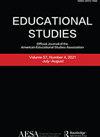基础教育调查研究中性别认同测量的问题:系统回顾
IF 1.6
4区 教育学
Q2 EDUCATION & EDUCATIONAL RESEARCH
引用次数: 0
摘要
摘要在美国和加拿大,越来越多的青少年自我认同为跨性别者,这使得学校迫切需要满足这些学生的需求,但教育调查研究者尚未找到基于性别和社会性别来评估他们教育成果的方法。在这篇重要的系统综述中,我概述了2009-2019年用于评估跨性别青年的性别和性别认同的调查。研究结果提出了一系列测量方法和研究兴趣类型,以及调查中缺失的重要方面。对那些目前或计划参与包括性别认同的调查研究的人的建议也包括在内。披露声明作者未报告潜在的利益冲突。注1方法说明:Google Scholar和Google是本次搜索的起点,因为这两个数据库产生的结果都经过同行评审和非同行评审我们通过电子邮件向熟悉青少年和成年人性别和性行为测量的人口统计学家和研究负责人咨询,以确定原始搜索中未包含的任何潜在调查,并获得使用的具体措辞。例如,GLSEN并没有在他们的报告中公开公布他们的调查,尽管它被广泛使用,并被称为教育研究中的大规模调查。在收到Joseph Kosciw的电子邮件后,他慷慨地回复了2019年NCSS调查中使用的项目的措辞2020-21年CHKS调查在询问性别时提供了以下回答:男性、女性、非二元性别,以及其他。本研究得到了Spencer Foundation[202000013]的支持。本文章由计算机程序翻译,如有差异,请以英文原文为准。
Problematizing the Measurement of Gender Identity in K-12 Education Survey Research: A Systematic Review
AbstractThe increase in youth’s self-identification as trans in the United States and Canada has created new urgency in schools to meet the needs of these students, yet education survey researchers have yet to find ways to assess their educational outcomes based on sex and gender. In this critical systematic review, I provide an overview of surveys from 2009–2019 that have been utilized to assess the sex and gender identity of trans youth. Findings suggest a range of measurement approaches and types of research interests, as well as important aspects that were absent from the surveys. Recommendations for those who currently or plan to engage with survey research that includes gender identity are included. Disclosure statementNo potential conflict of interest was reported by the author(s).Notes1 Methodological note: Google Scholar and Google were the starting point for this search, as both of these databases produced results that were peer-reviewed and non peer-reviewed.2 Demographers and research leaders familiar with measurement of gender and sexuality with youth and adults were emailed and consulted with, as a way to identify any potential surveys not located in the original search, as well as to obtain specific wording used. For example, GLSEN does not publish their survey publicly in their report even though it is widely used and known as a large-scale survey in education research. After an email from Joseph Kosciw, he graciously responded with the wording of the items used in the 2019 NCSS survey.3 The 2020–21 CHKS survey, in asking about gender, provided the following responses: male, female, nonbinary, something else.Additional informationFundingThis work was supported by Spencer Foundation [202000013].
求助全文
通过发布文献求助,成功后即可免费获取论文全文。
去求助
来源期刊

Educational Studies
EDUCATION & EDUCATIONAL RESEARCH-
CiteScore
5.50
自引率
0.00%
发文量
60
期刊介绍:
Educational Studies aims to provide a forum for original investigations and theoretical studies in education. The journal publishes fully refereed papers which cover applied and theoretical approaches to the study of education. Papers should constitute original research, and should be methodologically sound, theoretically informed, and of relevance to an international audience. The journal is particularly interested in research that aims to inform educational practice(s) within and/or across sectors. Whilst the journal is principally concerned with the social sciences, contributions from a wider field are also encouraged. Empirically-based papers are particularly welcome.
 求助内容:
求助内容: 应助结果提醒方式:
应助结果提醒方式:


